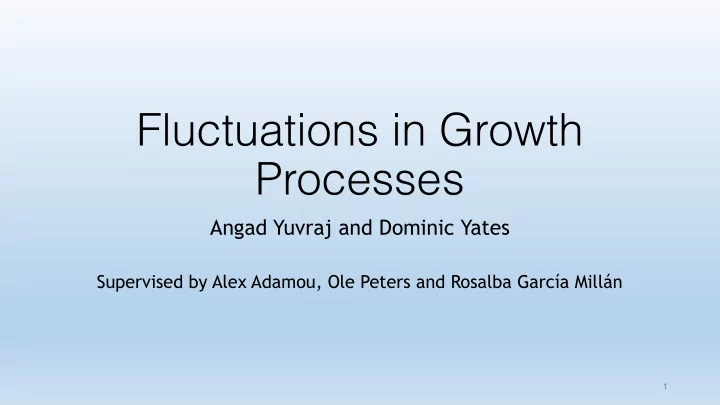

Fluctuations in Growth Processes Angad Yuvraj and Dominic Yates Supervised by Alex Adamou, Ole Peters and Rosalba García Millán 1
Introduction • Classical view holds that fluctuations are irrelevant to growth of a system. • Recent advancements demonstrate that fluctuations do play a role when considering the growth rate of the system. • It has been shown that individuals achieve boost in growth rate by completely pooling and equally splitting their resources. • We extend this concept to consider more practical forms of sharing than this type of “cooperation”. • We consider the effects of two types of resource sharing on growth rate, and the impact of fluctuations. 2
Geometric Brownian Motion • 3
Geometric Brownian Motion • 4
5
Cooperation • 6
7
Cooperation • 8
9
Our Model • The motivation behind our model came after studying a paper by Jain and Krishna on the evolution of a complex system. • The system comprised of elements that catalysed the growth of other elements. • We noted that this represented a system in which individuals were cooperating, except that there was no cost to the catalysis. • This meant that the system didn’t display the same conservation present in the previous cooperation model, in which individuals pooled and split resources. • Their guiding equation helped us to generalise the cooperation model. 10
Our Model • We consider a population of N individuals which interact through the giving and taking of resources, not necessarily in a symmetric manner. • We visualise this concept through graphs where each node represented an individual and directed edges represented the flow of resources. • We do not allow a node to have a directed edge to itself, and each node may have at most one directed edge towards each other node. • We allow edges to have different weights, corresponding to different rates of resource sharing. 11
The Weighted Adjacency Matrix • v 0.5 v v 1 v 1.1 v v 12
Our Model • 13
Receiving Giving Term Term Our Model • 14
Our Model • 15
Our Model • 16
The Deterministic Case • 17
Questions • What happens when individuals only engage in partial sharing? • What rate of sharing does it take to achieve maximum growth rate? • To what extent does growth rate depend on the way resources are distributed? • Does any of the above depend on how noisy the system is? 18
Complete Graph on N nodes • 19
Complete Graph on N nodes • Fully Connected Graph for N = 5 20
N-Cycle • N-Cycle for N = 5 21
The Complete Graph for N = 2 • 22
23
Normalised Growth, G • 24
Normalised Growth, G • 25
Normalised Growth, G • 26
27
28
29
Interpretation of Results for N = 2 • 30
31
Questions • What happens when individuals only engage in partial sharing? • What rate of sharing does it take to achieve a higher growth rate? • To what extent does growth rate depend on the way resources are distributed? • Does any of the above depend on how noisy the system is? 32
Finiteness of Time Length T • 33
34
Questions • What happens when individuals only engage in partial sharing? • What rate of sharing does it take to achieve maximum growth rate? • To what extent does growth rate depend on the way resources are distributed? • Does any of the above depend on how noisy the system is? 35
Fully Connected Graph for Different N • 36
37
38
Fully Connected Graph for Different N • 39
Form One Form Two • 40
Form One Form Two • 41
42
43
Similar Behaviour in Our Model • 44
45
46
Questions • What happens when individuals only engage in partial sharing? • What rate of sharing does it take to achieve maximum growth rate? • To what extent does growth rate depend on the way resources are distributed? • Does any of the above depend on how noisy the system is? 47
N-Cycle • 48
49
• 50
51
Questions • What happens when individuals only engage in partial sharing? • What rate of sharing does it take to achieve maximum growth rate? • To what extent does growth rate depend on the way resources are distributed? • Does any of the above depend on how noisy the system is? 52
53
54
55
Conclusion • In the absence of fluctuations, there is no incentive to cooperate. • Even a little sharing goes a long way. • The manner of distribution does have an impact on the growth rate. 56
Thank you for listening. • References: 1. “The Evolutionary Advantage of Cooperation”, O. Peters and A. Adamou http://arxiv.org/abs/1506.03414 “The Emergence and Growth of Complex Networks in Adaptive 2. Systems”, S. Jain and S. Krishna Computer Phys. Comm. 121-122 (1999) 116-121. 3. “Far from equilibrium: Wealth reallocation in the United States”, Y. Berman, O. Peters and A. Adamou http://arxiv.org/abs/1605.05631 “Note on mean-field wealth models and the Random Energy Model”, 4. Jean-Phillipe Bouchard (not published) 57
Recommend
More recommend